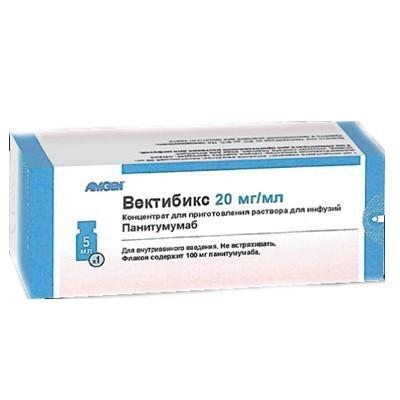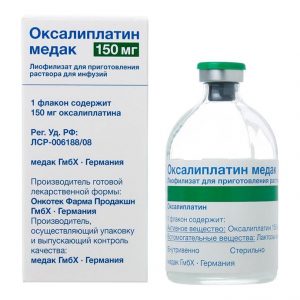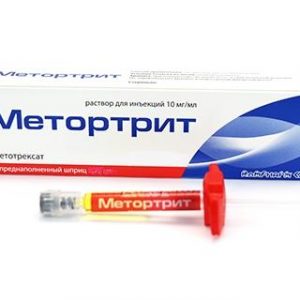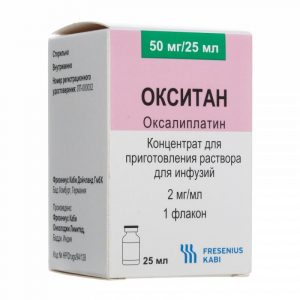Description
Release form
Concentrate for solution for infusion.
Packing
5 ml.
Pharmacological action of
Pharmacodynamics
Panitumumab is a human monoclonal antibody IgG2 obtained from a mammalian cell line (Chinese hamster ovary) by recombinant DNA technology. Panitumumab has a high affinity and specificity for receptors of human epithelial growth factor (EGF). EGF receptor is a transmembrane glycoprotein from the family of tyrosine kinase receptors of type I, which also includes HER1 / c-ErbB-1, HER2, HER3 and HER4. The EGF receptor stimulates the growth of normal epithelial cells, including skin and hair follicle cells, and is expressed on various types of tumor cells.
Panitumumab binds to the ligand-binding domain of the EGF receptor and inhibits the autophosphorylation process that is induced by all known EGF receptor ligands. The binding of panitumumab to the EGF receptor leads to internalization of the receptor, inhibition of cell growth processes, induction of apoptosis and a decrease in the production of interleukin-8 and vascular endothelial growth factor. The KRAS gene (Kirsten rat sarcoma 2 viral oncogen homologue) encodes a small guanosine triphosphate-binding protein that is involved in signal transduction. KRAS is activated by various signals, including from the EGF receptor, and, in turn, stimulates the synthesis of other intracellular proteins involved in cell proliferation, survival, and angiogenesis.
Activating mutations of the KRAS gene often occur in various human tumor cells and play a role in both oncogenesis and tumor progression.
Immunogenicity
The production of neutralizing antibodies to panitumumab was assessed using two different immunoassay methods (ELISA – enzyme-linked immunosorbent assay, which allows the determination of high affinity antibodies, and a biosensor, which allows the determination of high and low affinity antibodies). by the presence of antibodies to panitumumab, it was low. Antibodies to panitumumab prior to drug administration were found in 5 of 636 patients (<1%) and 16/635 patients (2.5%) according to immunoassays of ELISA and Biosensor, respectively. After administration of the drug, neutralizing antibodies to panitumumab were detected in 1 of 447 patients (0.2%) and 7 of 447 patients (1.6%) according to immunoassays of ELISA and Biosensor, respectively. When compared with patients in whom antibodies were not produced, the relationship between the presence of neutralizing antibodies to panitumumab and changes in pharmacokinetic parameters, efficacy and safety of the drug was not observed. Determination of antibodies depends on the sensitivity and specificity of the method used. A positive antibody test can be influenced by a variety of factors, including sampling techniques, concomitant medications, and the nature of the underlying disease, so comparing the incidence of antibodies to panitumumab with this indicator for other drugs may not be reliable. Clinical efficacy of The use of Vectibix in clinical trials in patients with metastatic colorectal cancer who have had a disease progression on the background or after a previous course of chemotherapy leads to an increase in progression-free survival (PFS), while the absolute value of PFS was greater in patients with KRAS wild-type in tumor cells compared to a group of patients with tumors with KRAS mutations. Pharmacokinetics When Vectibix is prescribed as monotherapy or in combination with chemotherapy, the pharmacokinetics of the drug is non-linear. After a single administration of panitumumab in the form of 1-hour infusion, AUC increased to a greater extent than is typical for dose-proportional dependence, and the clearance of the drug decreased from 30.6 to 4, 6 ml / day / kg with increasing doses from 0.75 to 9 mg / kg. However, with the introduction of panitumumab in doses above 2 mg / kg, the nature of the increase in AUC was close to dose-proportional dependence. Subject to the recommended dosage regimen (6 mg / kg once every 2 weeks as a 1-hour infusion), Css panitumumab is reached by the third infusion with average values of Cmax 213 ± 59 μg / ml and Cmin 39 ± 14 μg / ml. The average AUC value was 1306 ± 374 μg Day / ml, clearance – 4.9 ± 1.4 ml / kg / day. T1 / 2 of the drug was approximately 7.5 days (range from 3.6 to 10.9 days). According to the results of the analysis of pharmacokinetics in certain groups of patients (mainly aged 21-88 years), age, gender of the patient, race, liver and kidney function, the use of concomitant chemotherapeutic drugs and EGF, intensive membrane staining (1+, 2+ 3+) in tumor cells do not have a clear effect on the pharmacokinetics of panitumumab. Studies of the pharmacokinetics of panitumumab in patients with impaired renal or hepatic function have not been conducted. Indications Monotherapy of metastatic colorectal cancer with expression of EGF receptors and the non-mutant (wild) type of KRAS, with disease progression during or after a previous course of chemotherapy with fluoropyrimidine, oxaliplatin and irinotecan-containing regimens. Contraindications Vectibix is contraindicated in patients with a history of developing life-threatening hypersensitivity reactions to any of the components of the drug. interstitial pneumonitis or pulmonary fibrosis childhood (efficacy and safety in children under 18 have not been established) pregnancy lactation period. Composition 1 ml (1 vial) contains: Active substances: panitumumab 20 mg 100 mg. Excipients: sodium acetate trihydrate, sodium chloride, glacial acetic acid, d / i water. Side effects The most common adverse reactions when using Vectibix monotherapy were dermatological reactions, observed in approximately 93% of cases. These reactions are due to the pharmacological properties of Vectibix and usually have a mild or moderate severity in only 12% of cases, dermatological reactions are severe (severity 3 or higher, according to the classification of NCI-CTC). Frequent adverse reactions occurring in> 20% of patients were gastrointestinal disorders: nausea (30%), diarrhea (27%) and vomiting (22%) general reactions: increased fatigue (35%) of infection and infestation: paronychia (21% ) pathology of the skin and subcutaneous tissue: itching (53%), erythema (52%), acneiform dermatitis (51%) and rash (38%).
The following are data on adverse reactions observed in patients with metastatic colorectal cancer (mCRC) treated with panitumumab as monotherapy. The safety profile of panitumumab in patients with wild-type KRAS expression in tumor cells was generally similar to that for the mCRC monotherapy group. The only difference was that the pathology of nails and hypomagnesemia in the group of patients with increased expression of wild-type KRAS was higher ( 1/10) than in patients in the general population of mCRC monotherapy ( 1/100, <1/10), and stomatitis and acne were classified as common in the wild type KRAS group and as very common in the general population of mCRC monotherapy. In addition, bronchospasm, hypotension, and hypertension were classified as infrequent ( 1/1000, <1/100) in the general population of mCRC monotherapy and as frequent ( 1/100, <1/10) in the wild type KRAS group. Adverse reactions are presented in accordance with the following gradation in the frequency of their occurrence: very often ( 1/10), often ( 1/100, <1/10), rarely ( 1/1000 to <1/100), very rarely ( 1/10 000, <1/1000). Infections and infestations: very often – paronychia often – pustular rash, cellulitis, eye infection, infection of the eyelids. From the skin: very often – acne, acne, erythema, peeling of the skin, exfoliative rash, itching, dry skin, skin cracks, acneiform dermatitis often – papular rash, erythematous rash, macular rash, macular rash, macular rash itchy rash, skin ulcers, nail diseases (onychoclasia, onycholysis), hypertrichosis, alopecia, scabies, palmar-plantar erythrodysesthesia syndrome is very rare – angioedema. A skin rash developed during treatment with Vectibix was most often localized on the face, upper chest and back, however, in some cases it extended to the extremities. As a result of severe dermatological reactions, the development of infectious complications, such as sepsis, in rare cases with a fatal outcome, cellulitis and local abscesses requiring surgical intervention and drainage, was also noted. The median time to the development of the first manifestations of dermatological reactions was 10 days, and the median time to their resolution since the last injection of Vectibix was 28 days. Paronychia was accompanied by swelling of the lateral nail ridges of the fingers and toes. Dermatological reactions (including effects on the nails) observed in patients receiving Vectibix or other EGF inhibitors are known pharmacological effects of these drugs. According to the general population of mCRC monotherapy, severe (grades 3 and 4) reactions included acneiform dermatitis (5%), erythema (4%), rash (3%), pruritus (2%), exfoliative rash (1%), acne rash (1%), skin cracks (1%), peeling of the skin <1%), dry skin (<1%), skin ulcers (<1%), scabies (<1%), erythematous rash (<1%) papular rash (<1%) and maculopapular rash (<1%). Paronychia was observed in 1% of patients receiving Vectibix. From the digestive system: very often – diarrhea, nausea, vomiting, abdominal pain, constipation, stomatitis often – dryness of the oral mucosa. In most cases, diarrhea was mild or moderate, and only 2% of patients with wild-type KRAS expression had severe diarrhea. The development of acute renal failure with severe diarrhea and dehydration has been reported. From the respiratory system: very often – shortness of breath, cough often – dryness of the nasal mucosa, nosebleeds, pulmonary embolism rarely – bronchospasm. From the side of the organ of vision: often – conjunctivitis, increased lacrimation, hyperemia of the eyeball, dryness and irritation of the eyes, irritation of the eyelids, itchy eyes, increased eyelash growth. From the nervous system: often – headache, dizziness. Metabolic disorders: often – hypomagnesemia, hypocalcemia, hypokalemia, dehydration. Infusion reactions: during clinical trials and in the post-marketing period, the following adverse reactions were observed that occur within 24 hours after infusions: abdominal pain, anaphylactic reactions, angioedema, back pain, bronchospasm, cardiac arrest, chest pain, chills, cyanosis, shortness of breath, flushing, hypertension, hypotension, pyrexia, tachycardia, vomiting. Reactions to infusion (developing within 24 hours after the first injection of the drug) were observed in 3% of patients receiving Vectibix in clinical trials. The frequency of severe reactions (grade 3 and 4) was <1%. Serious infusion reactions, including reports of rare deaths, have been reported in post-marketing studies. The development of a case of fatal anginaedema in a patient with recurrent metastatic squamous cell carcinoma of the head treated with Vectibix has been reported. A fatal complication developed with the resumption of therapy after a previous episode of angioedema. Both reactions were recorded more than 24 hours after drug administration. Hypersensitivity reactions that developed more than 24 hours after the infusion were also reported in the post-marketing period. Other: very often – increased fatigue, pyrexia often – infusion reactions, inflammation of the oral mucosa, chills, chest discomfort, hypersensitivity, tachycardia, back pain rarely – anaphylactic reactions, flushing, hypotension, hypertension, cyanosis. Vectibix in combination with other anticancer drugs and / or as monotherapy. In all clinical trials in combination with other antitumor drugs and / or as monotherapy, the most serious side effects associated with Vectibix were pulmonary embolism, severe dermatological toxicity complicated by infection, and death due to sepsis, infusion reactions and hypomagnesemia. Adverse reactions requiring discontinuation of the Vectibix drug included infusion reactions, severe skin toxicity, and paronychia. Drug Interaction No drug interaction studies have been performed. Co-administration of Vectibix with chemotherapy regimens based on irinotecan, fluoropyrimidines, and folinate calcium (leucovorin) (IFL mode) or chemotherapy regimens including bevacizumab is not recommended. Increased mortality was observed with the administration of panitumumab in combination with chemotherapy regimens that included bevacizumab. Vektibix should not be given in combination with oxaliplatin-containing chemotherapy in patients with mCRC (metastatic colorectal cancer) with tumors characterized by mutant KRAS, or in the case of an unspecified KRAS tumor status. In a clinical trial, patients with tumors with KRAS mutated treated with panitumumab and FOLFOX noted a reduction in progression-free survival with no overall survival time. overdose Symptoms: Exceeding the recommended therapeutic dose, skin reactions, diarrhea, dehydration, and fatigue were approximately 2-fold higher, which was consistent with the safety profile of the drug at the recommended dose. Treatment: symptomatic therapy in case of overdose. Storage conditions Keep out of the reach of children, in the original packaging to protect from light, at a temperature of 2 ° to 8 ° C, do not freeze. Expiration 3 years. Special expiration date: Vektibix contains no antimicrobial preservatives or bacteriostatic agents. From a microbiological point of view, the drug should be used immediately after dilution. If the drug was not used immediately after dilution, the user is responsible for the time and conditions of its storage until the next injection (no more than 24 h at 2 ° to 8 ° C, unless the dilution was carried out under controlled and validated aseptic conditions). Do not freeze the diluted solution. Deystvuyuschee substances Panytumumab pharmacy terms and conditions prescription Dosage form Dosage form solution for infusion Menyufekchuring Amgen Limited, USA




